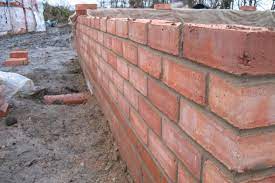What Surface Can You Lay Bricks On?
If you’re planning to build any sort of structure out of brick, you’ve probably opted for this material thanks to its stability and robustness. However, a brick structure is only ever as good as the surface it is laid on. If you want maximum strength then you’ll need to think carefully about where you are going to place your bricks. But what surface can you lay bricks on?
The best foundation for a brick wall is a trench filled with solid concrete. Taking the time to do this before building will ensure that your wall lasts longer not to mention the fact that it will be easier to build.
Of course, there are other surfaces that you can use for laying brick and it vastly depends on what you are building. For example, if you are laying a brick walkway in the garden, you would need a much softer surface, such as masonry sand, below the structure.
Can You Lay Brick On Wood?
If you want to build a vertical structure from brick such as a wall on wood then you have to consider the weight of the bricks once the wall is finished. Let’s assume you are attempting to build a structure indoors on wood flooring; it’s unlikely that the floor, especially on upper levels of the property, would have the strength to hold the finished wall. For this reason, we wouldn’t suggest attempting this.
When it comes to brick pavers, things are a little different and it is possible to lay them on top of a wooden surface. However, it is important to make sure that you use the correct type of mortar otherwise there is a risk of too much flex in the wood. Thinset mortar contains a latex additive which makes it much more flexible and therefore compatible with this type of surface.
Can You Lay Bricks On Soil?
When using bricks to create a driveway or walkway outdoors, it is likely that you will have to lay them on top of soil or dirt. This is entirely possible but you must always make sure that the ground is correctly prepared. Doing this will prevent the bricks from moving around and the structure will last many more years than it otherwise would.
In order to prepare the surface correctly, you will need to mark off the area you would like to build on before digging it out to a depth of around ten inches. Be sure to create a slight gradient to allow for proper drainage.
You’ll then need to layer the area. First you will place down some landscaping fabric to prevent weeds followed by a layer of gravel and a layer of sand. Ensure that everything is properly tampered down before laying your bricks.
Can You Lay Bricks On Tarmac?
Another surface that you may encounter when laying bricks outdoors is tarmac. There are times that you should not use bricks to cover this material and this largely applies if the surface is asphalt and you wish to use mortar. Moreover, you should avoid laying bricks onto tarmac that is heavily cracked. In this case, you will need to fill these cracks and properly prepare the surface before beginning.
Provided that the tarmac is in good condition, you should be able to lay bricks onto it without much of a problem. The area should be free from cracks and should not be breaking up. Furthermore, you will need to ensure that the area has been power washed as this will help to create a better bond between the two materials.
Can You Lay Bricks On Decking?
If you’ve got a decked area that seems like too much effort to pull up in order to lay down brick pavers then you might consider laying the brick over the top of the decking. But is this safe?
The problem with laying bricks over a wooden deck is that the structure is not designed to take this kind of weight. There has been a lot of discussion around the internet about laying down pavers and even an occasional porch over the top of a wooden deck but it’ll likely end in disaster.
Even if the decking was able to hold the weight of the brick, over time, rot would set in and weaken it meaning that eventually, the whole lot would become unsafe and potentially crumble.
Related Article: When Should You Clean Bricks After Laying Them
Can You Lay Bricks On Paving Slabs?
Building a small brick wall directly on top of paving slabs is not a wise move. The issue is that, while the paving slabs may appear to be pretty robust, they are not designed to take the weight of a brick wall. Over time, the weight of the structure will press down on the slabs causing them to shear at the base. The slabs will begin to sink and the whole structure will become unsafe.
For paving bricks, it may be possible to place these on top of paving slabs. In fact, this is usually much easier than trying to brighten up the area with a new layer of concrete or slabs. You’ll need to make sure that there are no significant cracks in the slabs and also that, once the bricks are laid, the surface does not interfere with any door thresholds or other access.
On top of the paving slabs, you will need to lay down a piece of landscaping fabric to prevent weeds from growing and then top this off with some sand to provide a stable base for the brickwork.
Conclusion
Having a good foundation for your brickwork is essential if you want the structure to remain strong and stable over the course of time. What material you use underneath your bricks will largely depend on the type of structure you are building. Generally speaking, a brick wall needs to be built upon a concrete trench to obtain the best stability.
